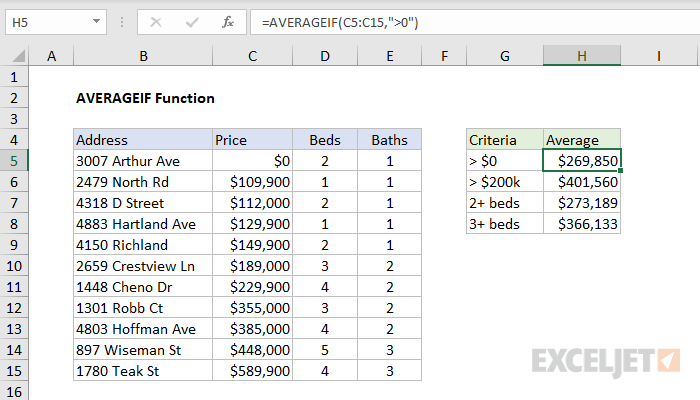Purpose
Return value
Syntax
=AVERAGEIF(range,criteria,[average_range])- range - One or more cells, including numbers or names, arrays, or references.
- criteria - A number, expression, cell reference, or text.
- average_range - [optional] The cells to average. When omitted, range is used.
Using the AVERAGEIF function
The AVERAGEIF function calculates the average of the numbers in a range that meet supplied criteria. To apply criteria, the AVERAGEIF function supports logical operators (>,<,<>,=) and wildcards (*,?) for partial matching. AVERAGEIF can be used to average cells based on dates, numbers, and text. Note that AVERAGEIF only handles one condition. To apply multiple conditions, use the AVERAGEIFS function.
Key Features
- Calculates averages based on one condition only (use AVERAGEIFS for multiple criteria)
- Supports logical operators (>, <, >=, <=, <>, =) and wildcards (*, ?) for flexible matching
- Automatically excludes empty cells from the average calculation (even when criteria match)
- Returns #DIV/0! error if no cells meet the specified criteria
- Works in all versions of Excel
Unlike most other Excel functions, AVERAGEIF requires an actual range for the range and average_range arguments. If you try to use an array, Excel will not let you enter the formula.
Syntax
The generic syntax for AVERAGEIF looks like this:
=AVERAGEIF(range,criteria,[average_range])The AVERAGEIF function takes three arguments: range, criteria, and average_range. Range is the range of cells to apply a condition to, and criteria is the condition to apply, along with any logical operators that are needed. Average_range argument is optional. When average_range is not provided, AVERAGEIF will average values in the range argument. When average_range is provided, AVERAGEIF will average values in average_range.
Criteria
The AVERAGEIF function supports logical operators (>,<,<>,=) and wildcards (*,?) for partial matching. Because AVERAGEIF is in a group of eight functions that split logical criteria into two parts, the syntax is a bit tricky. Range and criteria are provided separately, and operators in criteria need to be enclosed in double quotes (""). The table below shows some common examples:
| Target | Criteria |
|---|---|
| Cells greater than 75 | ">75" |
| Cells equal to 100 | 100 or "100" |
| Cells less than or equal to 100 | "<=100" |
| Cells equal to "Red" | "red" |
| Cells not equal to "Red" | "<>red" |
| Cells that are blank "" | "" |
| Cells that are not blank | "<>" |
| Cells that begin with "X" | "x*" |
| Cells less than A1 | "<"&A1 |
| Cells less than today | "<"&TODAY() |
Notice the last two examples use concatenation with the ampersand (&) character. When a criteria argument includes a value from another cell, or the result of a formula, logical operators like "<" must be joined with concatenation. This is because Excel needs to evaluate cell references and formulas first to get a value, before that value can be joined to an operator.
Examples
In the example shown, the formulas in H5:H8 are as follows:
=AVERAGEIF(C5:C15,">0") // price greater than $0
=AVERAGEIF(C5:C15,">200000") // price greater than $200k
=AVERAGEIF(D5:D15,">=2",C5:C15) // 2+ bedrooms
=AVERAGEIF(D5:D15,">=3",C5:C15) // 3+ bedrooms
Double quotes ("") in criteria
In general, text values are enclosed in double quotes (""), and numbers are not. However, when a logical operator is included with a number, the number and operator must be enclosed in quotes. Note the difference in the two examples below. Because the second formula uses the greater than or equal to operator (>=), the operator and number are both enclosed in double quotes.
=AVERAGEIF(D5:D15,2,C5:C15) // 2 bedrooms
=AVERAGEIF(D5:D15,">=2",C5:C15) // 2+ bedrooms
Double quotes are also used for text values. For example, to average values in B1:B10 when values in A1:A10 equal "red", you can use a formula like this:
=AVERAGEIF(A1:A10,"red",B1:B10) // average "red" only
Value from another cell
A value from another cell can be included in criteria using concatenation. In the example below, AVERAGEIF will return the average of numbers in A1:A10 that are less than the value in cell B1. Notice the less-than operator (which is text) is enclosed in quotes.
=AVERAGEIF(A1:A10,"<"&B1) // average values less than B1
Wildcards
The wildcard characters question mark (?), asterisk(*), or tilde (~) can be used in criteria. A question mark (?) matches any one character, and an asterisk (*) matches zero or more characters of any kind. For example, to average cells in a B1:B10 when cells in A1:A10 contain the text "red" anywhere, you can use a formula like this:
=AVERAGEIF(A1:A10,"*red*",B1:B10) // contains "red"
The tilde (~) is an escape character to allow you to find literal wildcards. For example, to match a literal question mark (?), asterisk(*), or tilde (~), add a tilde in front of the wildcard (i.e. ~?, ~*, ~~).
Average range caution
AVERAGEIF makes certain assumptions about the size of average_range, essentially resizing it when necessary to match the range argument, using the upper left cell in the range as an origin. In some cases, this behavior can create a result that seems reasonable but is in fact incorrect. For an example of this problem, see this article.
Notes
- TRUE and FALSE values ignored when calculating an average.
- Empty cells are ignored when calculating an average.
- AVERAGEIF returns #DIV/0! if no cells in range meet criteria.
- AVERAGEIF requires actual ranges - cannot use arrays for range arguments.
- Average_range does not have to be the same size as range. The top left cell in average_range is used as the starting point, and cells that correspond to cells in range are averaged.
- AVERAGEIF supports wildcards but is not case-sensitive.




















